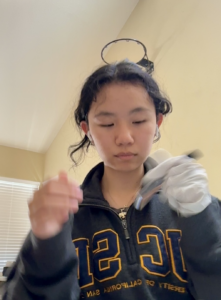Ratios, Again (Feat. Really Strong Phenyl Ethyl Alcohol)
May 1, 2024
Dear readers, here is this week’s updated blog post! Plus a photo of me blending that big bottle I talk about later in this post :))
Final (?) Ratio of Essential Oils vs Non-Essential Oils
Let’s see pick up where we left off last time: the small glass bottles and blending. I filled about four, five or so of them with the 1:9 ratio of different essential oils each, which—unfortunately—turned out not the be the right ratio for essential oils, at least. I feel like the mix-up came partially out of have two advisors who work with different types of media and perfume processes.
The Ratio of Notes
I’d brought to BISV a Ziploc bag full of scent strips—each with a different note I was considering, and shook it up, hoping the smelling of that Ziploc would convey the message of: “I’m a perfume! I smell good!” Unfortunately, and—funnily enough—the feedback I got back was that along the lines of “I’m actually an expensive, classy soap (dispenser). I do smell good though!” I mean, okay, fine.. it was a Ziploc bag with scent strips, some laying on top of each other, so having people smell the top of the Ziploc bag while shaking it and half-expecting an answer wasn’t exactly an accurate metric of what I’d done mixing different ratios of oils on one scent strip so far. But still—unexpected but good advice.
I set about to fix that by searching online, and also asking my advisors. A common thing they recommended was to add a top note like citrus (which I was worried about the phototoxicity of, but was reassured that perfume oils were in such small amounts it had very low risk of harming the body like that especially compared to body oils); I decided to perhaps use a different oil I’d already incorporate with the characteristics of a top note, but in larger amounts so it stood out more. Yosh also recommended I try blending in honey essential oil and adding less sandalwood to perhaps reduce the soap effect, which I will try.
Another thing she asked that made me think a bit more was having the oils represent specific parts of the painting (spoiler: the lace, the vibrant red, etc). I’d thought some in that direction but so far had been focused mainly on portraying the larger feeling/vibe of the painting, instead of representing smaller parts of it. So in some ways, I did incorporate parts of the painting into the notes, but also it was something I could definitely take more time to think about and experiment with.
The Fragrance Rough Drafts
Currently I’m working on making samples with a ratio of 3:7 essential oil to non-essential oil (the carrier—fractionated coconut oil—plus fixative and preservative).

For the first bigger-bottle sample I created (which had the 1:9 ratio), it was only after I used 10 mL total that I realized my preservative (phenyl ethyl alcohol, with a rosy, alcoholic note) and fixative (Perfumers Apprentice fixative) hadn’t been blended in yet. At that time, I’d thought that I’d just add in a few drops just to test out how much it’d change the fragrance, and oh boy it sure did. The whole thing started smelling like only the preservative…
The example ratio Lakenda had given me for preservatives and fixatives was, out of 165 mL of non-essential oil (or the “other”), she put 20 mL preservative (12% of the “other”) and 5-10 mL fixative (~5% of the “other”), so I felt a bit confused by how strong the scent of the phenyl ethyl alcohol was and wanted to experiment around with that. Yosh did also bring up that I was pipetting by hand and using my eye to measure generally how much of the 1 mL pipette was filled, so she recommended that I start with smaller 10 mL bottles (which I’m doing, yay!). Hopefully these few weeks are able to yield a more conclusive ratio and rough drafts!
Until Next Time
I hope you enjoyed this update on my Senior Project. Thanks for sticking by!
See you later,
Alina : )

Leave a Reply
You must be logged in to post a comment.